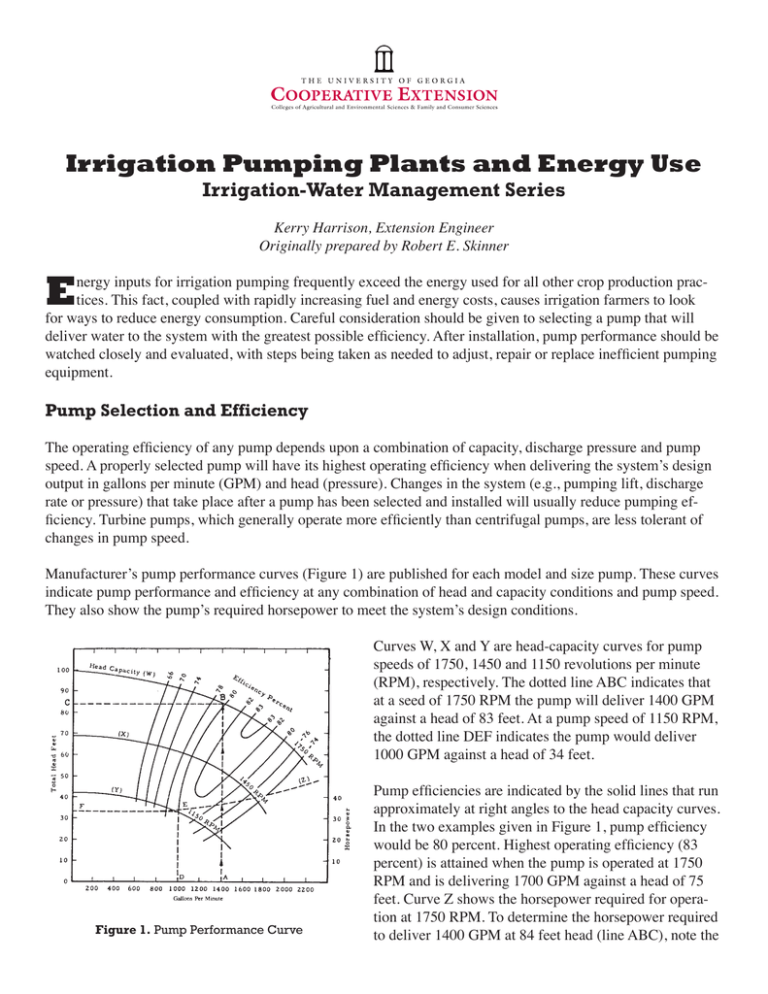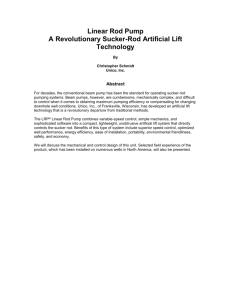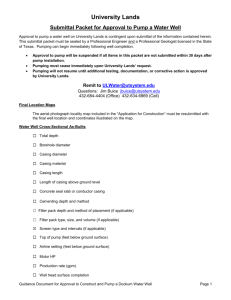E Irrigation Pumping Plants and Energy Use Irrigation-Water Management Series
advertisement

Irrigation Pumping Plants and Energy Use Irrigation-Water Management Series Kerry Harrison, Extension Engineer Originally prepared by Robert E. Skinner E nergy inputs for irrigation pumping frequently exceed the energy used for all other crop production practices. This fact, coupled with rapidly increasing fuel and energy costs, causes irrigation farmers to look for ways to reduce energy consumption. Careful consideration should be given to selecting a pump that will deliver water to the system with the greatest possible efficiency. After installation, pump performance should be watched closely and evaluated, with steps being taken as needed to adjust, repair or replace inefficient pumping equipment. Pump Selection and Efficiency The operating efficiency of any pump depends upon a combination of capacity, discharge pressure and pump speed. A properly selected pump will have its highest operating efficiency when delivering the system’s design output in gallons per minute (GPM) and head (pressure). Changes in the system (e.g., pumping lift, discharge rate or pressure) that take place after a pump has been selected and installed will usually reduce pumping efficiency. Turbine pumps, which generally operate more efficiently than centrifugal pumps, are less tolerant of changes in pump speed. Manufacturer’s pump performance curves (Figure 1) are published for each model and size pump. These curves indicate pump performance and efficiency at any combination of head and capacity conditions and pump speed. They also show the pump’s required horsepower to meet the system’s design conditions. Curves W, X and Y are head-capacity curves for pump speeds of 1750, 1450 and 1150 revolutions per minute (RPM), respectively. The dotted line ABC indicates that at a seed of 1750 RPM the pump will deliver 1400 GPM against a head of 83 feet. At a pump speed of 1150 RPM, the dotted line DEF indicates the pump would deliver 1000 GPM against a head of 34 feet. Figure 1. Pump Performance Curve Pump efficiencies are indicated by the solid lines that run approximately at right angles to the head capacity curves. In the two examples given in Figure 1, pump efficiency would be 80 percent. Highest operating efficiency (83 percent) is attained when the pump is operated at 1750 RPM and is delivering 1700 GPM against a head of 75 feet. Curve Z shows the horsepower required for operation at 1750 RPM. To determine the horsepower required to deliver 1400 GPM at 84 feet head (line ABC), note the point at which line A-B crosses curve Z. According to the scale to the right, approximately 37 HP is required. The effect that pump efficiency has on horsepower requirement and energy input can best be illustrated by the standard equation for determining horsepower: HP = Q (capacity) x H (head) 3960 x E (efficiency) Assume our pumping conditions are 1000 gallons per minute against a total head (pressure) of 350 ft. and we are choosing between two pumps. Pump #1 has an efficiency of 75 percent and Pump #2 has an efficiency of 50 percent. When we substitute these efficiency values in the horsepower equation, we find Pump #1’s horsepower requirement to be 118 HP and Pump #2’s to be 177 HP. By selecting the pump with higher efficiency, we have accomplished two things: (1) we are able to use a significantly smaller power unit, and (2) we see a fuel savings on the order of 4 to 5 gallons (of diesel) per hour of operation each time we operate the system. Causes of Substandard Pump Performance Over a period of time, pump parts will wear, resulting in reduced pumping efficiency. Part wear will be greatly accelerated if the water being pumped contains sand, silt or gravel. Measurements of discharge rate (GPM) and discharge pressure may be used to check a pump’s efficiency using the manufacturer’s pump performance curves. • Changes in pumping lift or well yield affect the pumping efficiency of turbine pumps. If such changes occur, the pump may need to be pulled, redesigned to fit existing conditions, and/or proper components installed for maximum pumping efficiency. Any change in horsepower resulting from changing the number of bowls, lowering the pump setting or any other alterations will also need to be considered. • Piping systems not included in the original system design will change pumping conditions and efficiency. Turbine pump impellers may be out of adjustment, resulting in higher than normal engine speeds necessary to deliver the required volume of water. The pump may also be operating below or above the design speed. • The drive ratio may be incorrect for matching pump and engine speeds, causing inefficient operation of pump or engine or both. Drive misalignment lowers efficiency and reduces the life of the drive. Power Units for Pumping Power units used for irrigation pumping in Georgia include diesel engines, LP gas and gasoline engines, and electric motors. According to the latest irrigation survey data, diesel engines comprised 15 percent of all irrigation power units used in Georgia, gasoline and LP gas together accounted for less than 5 percent, and electric motors comprised more than 80 percent of the total. This is in sharp contrast to 30 years ago when diesel engines compromised more than 80 percent of all power units. Power units should be selected to match the power requirements of the pumping application. Overloading a power unit may shorten its useful life significantly, while power units too big for the job operate at reduced efficiency. The efficiency of electric motors ranges from 85 to 92 percent. Large electric motors (above 15 to 20 horsepower) are more efficient than small electric motors. Gasoline engines operate at efficiencies of 20 to 30 percent. Diesel industrial engines of the type used for irrigation operate at efficiencies of 25 to 50 percent, depending on age and condition. When making power cost comparisons between different makes and models of engines and between different fuel options, power costs are usually expressed in terms of cost per horsepower-hour (Hp-Hr). In the case of internal combustion engines, calculations should be based on continuous duty (derated) horsepower – not on the manufacturer’s advertised maximum or bare engine horsepower. In derating an engine percentage, deductions are made from the maximum rated brake horsepower (BHP) for a specific operating speed. Examples of these include 20 percent deduction for continuous load, 3 percent deduction for each 1000 ft. above sea level, 1 percent deduction for each 10° rise of ambient air temperature over 60°F, 5 percent deduction for accessories, and 5 percent deduction for fan and radiator. Some manufacturers rate their engines for continuous operation. In these cases, the deduction for continuous operation has already been made. Electric motors need to be derated from nameplate horsepower because manufacturers base this rating on 70°F air temperatures and a 10 to 15 percent overload factor – a built-in service factor to compensate for varying temperature and voltage conditions. Fuel-Energy Conversion Internal combustion engines vary considerably in their ability to convert petroleum fuel into mechanical energy. Proper maintenance and tune-ups do much to keep engines operating efficiently. Many irrigation engines have been selected on the basis of low initial cost. This usually results in a smaller engine being operated at its upper limits of engine speed (RPM), which not only shortens engine life, but frequently increases the amount of fuel consumed per horsepower-hour of output. Manufacturers’ engine performance data often includes a curve showing the “amount of fuel per horsepower-hour” output at various speeds. Fuel consumption per horsepower-hour may well be more important than initial cost over the life of the engine. Electric motors, especially three-phase units, are inherently quite efficient in converting electrical energy into mechanical motion. One advantage of the electric motor is that it draws no more current than is necessary to do the job. Excessive overloading, however, causes excessive temperature rise, resulting in premature motor failure. Evaluating Pumping Plant Performance Performance evaluation of a pumping plant involves two things: (1) determining the plant performance with a performance test, and (2) comparing that test result to a performance standard. The test results indicate the amount of useful work actually obtained from each unit of fuel or electrical energy. The standard indicates the amount of work per unit of fuel or energy that should be obtained with an efficiently operating unit. Table 1 shows established standards of performance in water horsepower hours (WHP-Hrs) per unit of fuel or electrical energy for irrigation pumping plants. If a pumping plant is found to be operating substantially below the performance standard, steps should be taken to improve operating efficiency. Table 1. Performance Standard Fuel WHP-Hrs per Unit of Fuel or Energy Propane 6.89 per gallon Butane 7.65 per gallon Gasoline 8.66 per gallon Diesel 12.5 per gallon Electricity .885 per kilowatt hour (kwh) Performance Test Information that must be obtained during the performance test includes: pumping rate, pumping lift, discharge pressure or head, and the amount of fuel or energy used per hour. Pumping rate is measured in gallons per minute and any method that provides an accurate measurement may be used. Water measuring devices include propeller-type flow meters, pipe orifices and weirs. The water level while pumping is measured in feet from the center line of the pump discharge to water level. For a deep well, this may be accomplished with an electric water level sounder or with an air line. The discharge head or pressure may be obtained by reading the pressure gauge at the pump discharge. Multiply the pressure reading by 2.31 to change discharge pressure in pounds per square inch to discharge head in feet. Fuel, or energy used per hour, can be determined from measured fuel consumption in gallons per hour (gasoline, diesel) or from electric meter reading in kilowatt hours per hour (electricity). A reasonably accurate determination of electrical energy can be made by counting the meter disc revolutions during a short period of time and using the following formula to determine kilowatt hours per hour. KWH input/hour = 3.6 x kh factor on meter x R disc revolutions Time in seconds for R disc revolutions The measurements of pumping rate in gallons per minute and total head (lift plus discharge pressure or head in feet) are used to determine water horsepower (WHP) – the rate work is done by the pumping plant. Water horsepower (WHP) = GPM x Head (ft.) 3960 Water horsepower divided by the amount of fuel or energy used per hour during the test period gives pumping plant performance in terms of WHP-Hrs per unit of fuel. This value is then compared to the performance standard in Table 1. Based on tests of pumping plants being operated in Nebraska over a seven-year period, only 24 percent of units tested exceeded 90 percent of the standards in Table 1. The average plant operated at about 76 percent of the standard. After adjustments to units tested were made, pumping plant efficiency was increased by an average of 10 percent. Tests conducted in Georgia from 1982 to 1988 indicated very similar results. Bulletin 837 Revised May 2009 The University of Georgia and Ft. Valley State University, the U.S. Department of Agriculture and counties of the state cooperating. Cooperative Extension, the University of Georgia College of Agricultural and Environmental Sciences, offers educational programs, assistance and materials to all people without regard to race, color, national origin, age, gender or disability. An Equal Opportunity Employer/Affirmative Action Organization Committed to a Diverse Work Force




